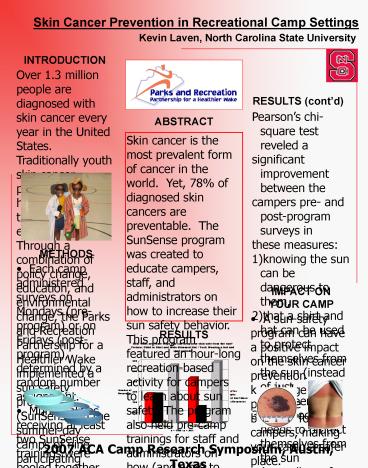Kevin Laven, North Carolina State University - PowerPoint PPT Presentation
1 / 1
Title:
Kevin Laven, North Carolina State University
Description:
A total of 1155 campers in 9 different week-long day camps between the ages of 5 ... campers pre- and post-program surveys in. these measures: ... – PowerPoint PPT presentation
Number of Views:42
Avg rating:3.0/5.0
Title: Kevin Laven, North Carolina State University
1
Skin Cancer Prevention in Recreational Camp
Settings
Kevin Laven, North Carolina State University
INTRODUCTION
Over 1.3 million people are diagnosed with skin
cancer every year in the United States.
Traditionally youth skin cancer prevention
efforts have focused on the primary education
setting. Through a combination of policy change,
education, and environmental change, the Parks
and Recreation Partnership for a Healthier Wake
implemented a sun safety program (SunSense) in
the summer day camps of nine participating
municipalities in Wake County, NC. This study
focused on measuring the difference in campers
knowledge and self-predicted behaviors in a
week-long, day camp setting.
RESULTS (contd)
- Pearsons chi-square test reveled a
- significant improvement between the
- campers pre- and post-program surveys in
- these measures
- knowing the sun can be dangerous to them,
- that a shirt and hat can be used to protect
themselves from the sun (instead of just
sunscreen), - everybody needs to protect themselves from the
sun (regardless of skin color), - they should wear SPF 15 or higher sun block,
- they will wear hats and long-sleeved shirts more
often, - they should avoid direct sunlight from 10am to
3pm, - suntans do not make people look healthy,
- suntans are not good for their own skin,
- they will attempt to play in the shade more often
this summer, and - the sun does good and bad things to people (helps
plants grow but can hurt them too).
ABSTRACT
Skin cancer is the most prevalent form of cancer
in the world. Yet, 78 of diagnosed skin cancers
are preventable. The SunSense program was
created to educate campers, staff, and
administrators on how to increase their sun
safety behavior. This program featured an
hour-long recreation-based activity for campers
to learn about sun safety. The program also held
pre-camp trainings for staff and administrators
on how (and why) to implement a sun safe behavior
program in their camp setting. The purpose of
this study was to measure the effectiveness of
this multi-component sun safety program on the
campers. A total of 1155 campers in 9 different
week-long day camps between the ages of 5-12
years old completed the surveys used in this
study. The findings showed a positive
significant difference in many of the areas
tested on knowledge and self-predictive
behaviors that relate to sun safety. These data
support the notion that skin cancer prevention
programs can be effective in the camp setting and
is a worthy pursuit for continued cancer
prevention efforts outside of the primary school
setting. It is believed that a link between skin
cancer prevention and recreational camps will
lead to increased funding and importance given to
camps from the allied health industry.
METHODS
- Each camp administered surveys on Mondays
(pre-program) or on Fridays (post-program),
determined by a random number assignment. - Municipalities receiving at least two SunSense
trainings were pooled together and then randomly
assigned to either the pre- or post- program
surveys to determine intra-department
effectiveness. - The survey was a modified version of a survey
used by the Environmental Protection Agency (EPA)
for its SunWise program in primary schools due to
its established validity measures. - Only generalist recreational camps were
chosen that had a variety of activities (outdoor
and indoor activities, outdoor pools).
IMPACT ON YOUR CAMP
- A sun-safety program can have a positive impact
on the skin cancer prevention knowledge and
predictive behavior for your campers, making your
camp a safer place. - A link created between the skin cancer
prevention programs and recreational camps can
increase funding avenues for supporting camp
activities and general safety.
RESULTS
2007 ACA Camp Research Symposium, Austin, Texas































